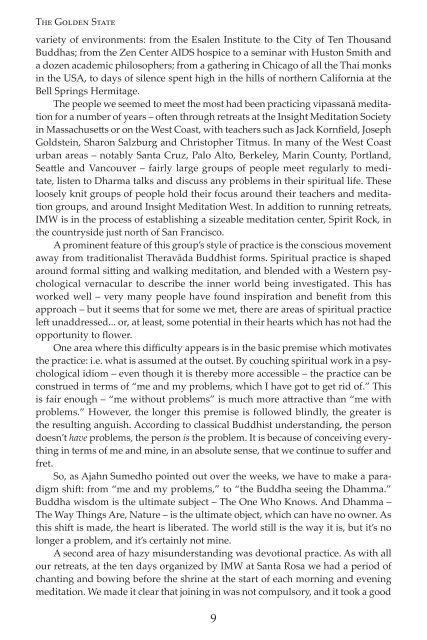Rugged Interdependency - Amaravati Buddhist Monastery
Rugged Interdependency - Amaravati Buddhist Monastery
Rugged Interdependency - Amaravati Buddhist Monastery
- No tags were found...
You also want an ePaper? Increase the reach of your titles
YUMPU automatically turns print PDFs into web optimized ePapers that Google loves.
The Golden Statevariety of environments: from the Esalen Institute to the City of Ten ThousandBuddhas; from the Zen Center AIDS hospice to a seminar with Huston Smith anda dozen academic philosophers; from a gathering in Chicago of all the Thai monksin the USA, to days of silence spent high in the hills of northern California at theBell Springs Hermitage.The people we seemed to meet the most had been practicing vipassanā meditationfor a number of years – often through retreats at the Insight Meditation Societyin Massachusetts or on the West Coast, with teachers such as Jack Kornfield, JosephGoldstein, Sharon Salzburg and Christopher Titmus. In many of the West Coasturban areas – notably Santa Cruz, Palo Alto, Berkeley, Marin County, Portland,Seattle and Vancouver – fairly large groups of people meet regularly to meditate,listen to Dharma talks and discuss any problems in their spiritual life. Theseloosely knit groups of people hold their focus around their teachers and meditationgroups, and around Insight Meditation West. In addition to running retreats,IMW is in the process of establishing a sizeable meditation center, Spirit Rock, inthe countryside just north of San Francisco.A prominent feature of this group’s style of practice is the conscious movementaway from traditionalist Theravāda <strong>Buddhist</strong> forms. Spiritual practice is shapedaround formal sitting and walking meditation, and blended with a Western psychologicalvernacular to describe the inner world being investigated. This hasworked well – very many people have found inspiration and benefit from thisapproach – but it seems that for some we met, there are areas of spiritual practiceleft unaddressed... or, at least, some potential in their hearts which has not had theopportunity to flower.One area where this difficulty appears is in the basic premise which motivatesthe practice: i.e. what is assumed at the outset. By couching spiritual work in a psychologicalidiom – even though it is thereby more accessible – the practice can beconstrued in terms of “me and my problems, which I have got to get rid of.” Thisis fair enough – “me without problems” is much more attractive than “me withproblems.” However, the longer this premise is followed blindly, the greater isthe resulting anguish. According to classical <strong>Buddhist</strong> understanding, the persondoesn’t have problems, the person is the problem. It is because of conceiving everythingin terms of me and mine, in an absolute sense, that we continue to suffer andfret.So, as Ajahn Sumedho pointed out over the weeks, we have to make a paradigmshift: from “me and my problems,” to “the Buddha seeing the Dhamma.”Buddha wisdom is the ultimate subject – The One Who Knows. And Dhamma –The Way Things Are, Nature – is the ultimate object, which can have no owner. Asthis shift is made, the heart is liberated. The world still is the way it is, but it’s nolonger a problem, and it’s certainly not mine.A second area of hazy misunderstanding was devotional practice. As with allour retreats, at the ten days organized by IMW at Santa Rosa we had a period ofchanting and bowing before the shrine at the start of each morning and eveningmeditation. We made it clear that joining in was not compulsory, and it took a good
















